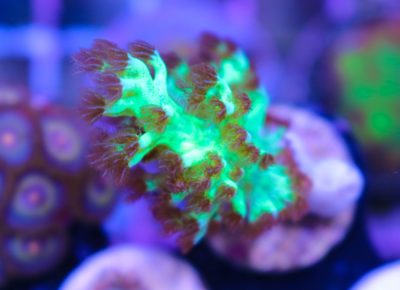Common Name: Finger Leather
Scientific Name: Nephthea sp.
Origin: Fiji, Tonga, Solomon Islands and Great Barrier Reef
Category: Soft Coral
Care Level: Beginner
Temperament: Chemically agressive
Lighting: Low – Medium
Waterflow: Medium
Placement: Any
Colors: Various
Growth Speed: Fast
Nephthea leathers are an easy going, fast growing, coral that many levels of reefers can enjoy. They like stronger water movement mixed with a medium intensity light and are usually happy in the mid section or tops of outer corners in reef aquariums.
 Dr. Fuzzy Nephthea Leather from our FCC aquaculture program.
Dr. Fuzzy Nephthea Leather from our FCC aquaculture program.
 Placement
Placement
The nepthea leather is rather tolerant of different areas of the reef and is an excellent candidate for early, young tank, coral additions. They prefer a moderately lit section of rock with lots of space above allowing them room to grow upwards.
Water flow is key to the longevity of this coral. If there is not enough flow, mucous produced by the leather will not effectively be able to shed off, thus not allowing the coral to expand fully. Place nepthea leathers in a moderate flow section of the reef to keep it happy and to keep the polyps extended.
 Unique variety of finger leather
Unique variety of finger leather
 Feeding
Feeding
This coral will thrive in a tank without feeding, given that there is good quality lighting, as it relies heavily on the photosynthesis of its zooxanthellae. Nephthea coral polyps are capable of trapping micro-fauna and phytoplankton, so a fine particle food is preferred. It is not neccesary to feed this coral, however, isn’t harmful for the coral to have supplemental feeding occasionally.
 Propagation
Propagation
Nephthea leathers are widely available within the reef keeping hobby. Due to this corals fast growing properties and wide colour varieties, there is much opportunity for propagating this species. It is easy to cut the flesh of nephthea leathers with either scissors or a blade. However, attaching frags to plugs and/or rockwork posses a challenge. Placing the fragments in a low flow area, preferably in a container, on top of rubble rock will allow for each piece to slowly grow over the rubble. You can then take your fragments and glue them to any surface. Although tedious, we have had much success by sewing nephthea frags to plugs and rubble. After sewn, you can place your coral onto its’ permanent position.
 Common neon green Nephthea leather
Common neon green Nephthea leather
